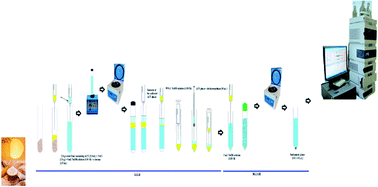Monitoring of nine pesticides in different cereal flour samples with high performance liquid chromatography-diode array detection
Abstract
In the present work, a sample preparation method based on liquid–liquid–liquid extraction combined with dispersive liquid–liquid microextraction has been developed and validated for the extraction and preconcentration of nine multiclass pesticide residues from selected cereals and their determination by high-performance liquid chromatography-diode array detection. The extraction mechanism is based on different affinities of the components of the samples towards each of the involved phases (aqueous solution, acetonitrile, and n-hexane). In this procedure, initially acetonitrile is added to the solid sample and vortexed to extract the analytes along with other co-extracted compounds such as fats, lipids, etc. To clean-up the sample an aqueous phase (NaOH solution), a clean-up solvent (n-hexane) and a phase separating agent (NaCl) are added into the extract. In the presence of the phase separating agent a three-phase system is formed and simultaneously hydrophobic compounds are extracted into n-hexane and polar compounds migrate into the aqueous phase, while the analytes remain in the acetonitrile phase. Next, for more enrichment of the analytes, the acetonitrile phase is mixed with dichloromethane to perform the following dispersive liquid–liquid microextraction procedure. The influence of different experimental parameters on the extraction efficiency of the method was investigated. Under the optimum extraction conditions, enrichment factors for the selected pesticides were obtained in the range of 221–359. Limits of detection and quantification were obtained in the ranges of 0.16–0.60 and 0.53–2.0 ng g−1, respectively, with extraction recoveries of 55–90%. Relative standard deviations were in the ranges of 2–6% for intra- (n = 6) and 3–7% for inter-day (n = 5) precisions (C = 10 or 50 ng g−1 of each analyte). Finally, the proposed method was applied on different types of cereals including wheat, buck wheat, barley, rice, corn, chickpea, soya, and semolina. Clodinafop-propargyl was determined at the concentrations of 21 ± 2 and 16 ± 1 ng g−1 (n = 3), respectively, in whole wheat and wheat sprout flour samples.



 Please wait while we load your content...
Please wait while we load your content...